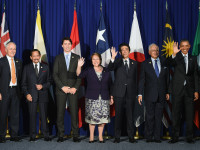The official release of the Trans Pacific Partnership (TPP), a global trade agreement between 12 countries including Canada, the United States, and Japan, has generated considerable confusion over where the Trudeau government stands on the deal. The TPP was concluded several weeks before the October election and the Liberals were careful to express general support for free trade, but refrain from embracing an agreement that was still secret.
Over the past month, there have been mixed signals over the issue. Chrystia Freeland, the new Minister of International Trade, has committed to a public consultation and noted that her government is not bound by commitments made by the Conservatives (in the interests of full disclosure, I had the opportunity to meet with Minister Freeland to discuss the TPP earlier this month). Yet following a meeting between Prime Minister Justin Trudeau and U.S. President Barack Obama at the APEC conference in Manila, Obama indicated that he expects Canada to soon be a signatory to the deal.
How to explain the seemingly inconsistent comments on the Canadian position on the TPP? The answer may well lie in the differences between reaching an agreement-in-principle, signing the formal text, and ratifying the deal. Each step is distinct and carries different legal obligations.







